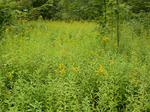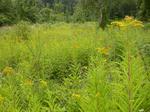| Home | About BFIS | Species List | Risk Analysis | Harmonia⁺ | Resources | Outputs | Mailing List | Registry |
| Contact us | Login | | ||||||
 |

©
Sonia Vanderhoeven, FUSAGx

©
Etienne Branquart

©
Etienne Branquart
 Naturalization in Belgium Naturalization in Belgium
 Invasiveness Invasiveness
More on invasiveness: The plant is found in many disturbed and nitrogen-rich sites: ruderal areas, fallow lands, abandonned fields, river banks, etc. It also colonises humid grasslands.
 Distribution in Belgium Distribution in Belgium
Established populations

Endangered areas

 Impacts on Species Impacts on Species
 Impacts on Ecosystems Impacts on Ecosystems
More on impacts: The plant can build up dense and long lasting populations, and easily outcompetes native plants, including tree seedlings. Competitive ability is favoured by allelopathic interactions. Once established, the plant may remain dominant for a long period of time and often prevents natural colonisation by woody species.
References:
AEF (2006)
Cartes provisoires de la distribution de néophytes en Wallonie.
Unpublished document.
CPS-SKEW (2006)
Solidago gigantea
From online fact sheets of the Swiss Commission for Wild Plants Conservation.
Hejda, M., Pysek, P. & Jarosik, V. (2009)
Impact of invasive plants on the species richness,
diversity and composition of invaded communities.
 Journal of Ecology 97: 393–403.
Jakobs, G., Weber, E. & Edwards, P.J. (2004)
Introduced plants of the invasive Solidago
gigantea (Asteraceae) are larger and grow denser than conspecifics in the native range.
 Diversity and Distributions 10: 11–19.
Kabuce, N. (2006)
Invasive alien species fact sheet: Solidago canadensis.
From online database of the North European and Baltic network on invasive alien species (NOBANIS).
Lambinon, J., Delvosalle, L. & Duvigneaud, J. (2004)
Nouvelle fore de la Belgique, du Grand-Duché de Luxembourg, du Nord de la France et des régions voisines.
Editions du Patrimoine du Jardin botanique national de Belgique, Meise.
Van Landuyt, W., Hoste, I., Vanhecke, L., Van den Bremt, P. Vercruysse, W. & De Beer, D. (2006)
Atlas van de Flora van Vlaanderen en het Brussels gewest.
Nationale Plantentuin en het Instituut voor Natuur- en Bosonderzoek i.s.m. Flo.Wer vzw.
Vanderhoeven, S., Dassonville, N. & Meerts, P. (2005)
Increased topsoil mineral nutrient concentrations under exotic invasive plants in Belgium.
Pland and Soil 275: 169-179.
Verloove, F. (2006)
Scripta Botanica Belgica 39, 89 pp.
Weber E. (2011)
Strong regeneration ability from rhizome fragments in two invasive clonal plants (Solidago canadensis and S. gigantea)
 Biological Invasions (2011) DOI 10.1007/s10530-011-9977-y
Weber, E. & Gut, D. (2004)
Assessing the risk of potentially invasive plant
species in central Europe.
Journal for Nature Conservation12: 171-179.
|
 |
 |








